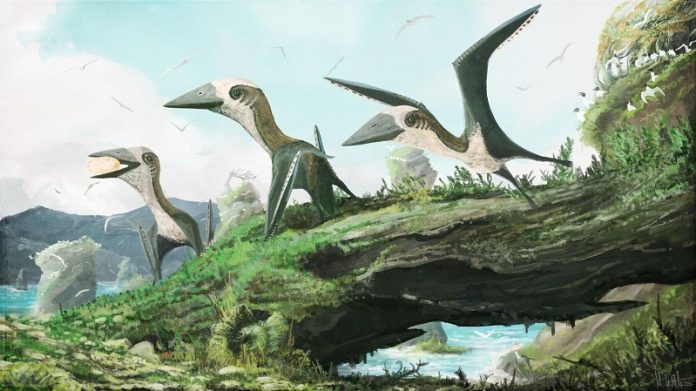
In the age of dinosaurs, not all creatures were as big as we often think!
Scientists have recently found remains of a small flying dinosaur, or pterosaur, from around 77 million years ago.
This discovery is special because it’s the first of its kind on the west coast of North America.
Even more fascinating is that it was much smaller than most of the pterosaurs of its time, having a wingspan of just 1.5 meters, while others had wingspans of up to 11 meters, nearly the size of a small plane!
This little pterosaur’s remains, found in British Columbia, Canada, include a bone from its upper wing (the humerus) and several backbones. The creature is a type of azhdarchoid pterosaur, a group of short-winged and toothless dinosaurs that were among the last pterosaurs to evolve.
Up until now, scientists thought that only large pterosaurs and birds flew the skies in the Late Cretaceous period, the last segment of the dinosaur age.
However, this small pterosaur’s discovery, published in the Royal Society journal Open Science, tells us that there was more diversity among flying dinosaurs than previously believed.
Elizabeth Martin-Silverstone, the study’s lead author and a PhD student in Palaeobiology at the University of Southampton, explained why this discovery is so important.
She said, “This new pterosaur is exciting because it suggests that small pterosaurs were present all the way until the end of the Cretaceous, and weren’t outcompeted by birds.”
She noted that pterosaurs’ bones are hollow and delicate, which makes them difficult to preserve. As a result, it’s rare to find small pterosaur fossils, but that doesn’t mean they didn’t exist.
The fossil fragments were found in 2009 by a collector and volunteer from the Royal British Columbia Museum. They were analyzed by Martin-Silverstone and other scientists, who concluded that the pterosaur was not a young or small member of a larger species, but a fully grown small species.
According to Martin-Silverstone, the lack of smaller juveniles of large species in the fossil record suggests that there is a bias against preserving small pterosaurs.
She believes this find proves that the Late Cretaceous period wasn’t just ruled by giant species, but smaller ones like this pterosaur had their place too.
It’s a reminder to researchers to look more closely at collections for possible misidentified or overlooked pterosaur fossils. In doing so, they may find more evidence of the diversity of these fascinating flying dinosaurs.



